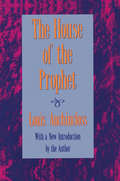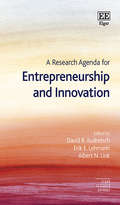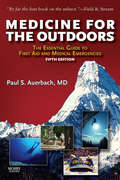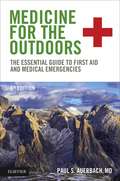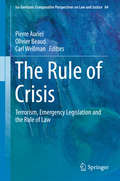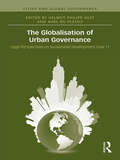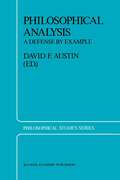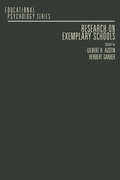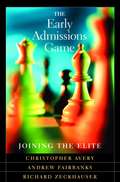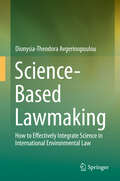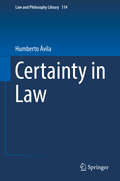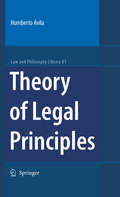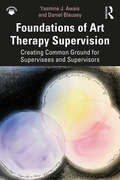- Table View
- List View
The House of the Prophet
by Louis AuchinclossThe House of the Prophet is Louis Auchincloss's searching novel of Felix Leitner, one of the most influential men of his time. Political philosopher, columnist, adviser to American presidents, Leitner will doubtless bring to many readers' minds the late Walter Lippmann, portrayed in the fine biography by Ronald Steel. Indeed, in his new introduction, Auchincloss makes plain that "the idea of writing a novel inspired by, though by no means based upon, the life of Walter Lippmann was unlike any fictional idea that I have had before or since." He candidly adds, "I was always perfectly aware the Felix Leitner, the protagonist of The House of the Prophet, would be instantly related to Walter Lippmann, and I had no objection to this." Whether considered on its own merits or as a major statement on Lippmann, this volume deserves close scrutiny.
The House of the Prophet
by Louis AuchinclossThe House of the Prophet is Louis Auchincloss's searching novel of Felix Leitner, one of the most influential men of his time. Political philosopher, columnist, adviser to American presidents, Leitner will doubtless bring to many readers' minds the late Walter Lippmann, portrayed in the fine biography by Ronald Steel. Indeed, in his new introduction, Auchincloss makes plain that "the idea of writing a novel inspired by, though by no means based upon, the life of Walter Lippmann was unlike any fictional idea that I have had before or since." He candidly adds, "I was always perfectly aware the Felix Leitner, the protagonist of The House of the Prophet, would be instantly related to Walter Lippmann, and I had no objection to this." Whether considered on its own merits or as a major statement on Lippmann, this volume deserves close scrutiny.
A Research Agenda for Entrepreneurship and Innovation (Elgar Research Agendas)
by David B. Audretsch Erik E. Lehmann Albert N. LinkElgar Research Agendas outline the future of research in a given area. Leading scholars are given the space to explore their subject in provocative ways, and map out the potential directions of travel. They are relevant but also visionary. Within the span of a generation, innovation and entrepreneurship have emerged as two of the most vital forces in the economy and in society. This Research Agenda highlights new insights and approaches to guide future thinking, research and policy in the area. To accomplish this, the editors have brought together a group of accomplished scholars spanning economics, management, public policy and finance. Drawing on the experiences and insights of leading scholars this Research Agenda covers a broad array of rich and promising topics, including entrepreneurial ecosystems, finance and the role of universities. Focusing on the intersection and overlap between the two disciplines, the Research Agenda begins by establishing the theoretical basis between the two topics, before exploring impact, context, academic entrepreneurship, start-ups, policy and corporate governance. The book concludes with three provocative chapters: Friederike Welter highlighting the power of words and images, Sameeksha Desai discussing the role of artificial intelligence and Mark Casson presenting a case for radical change to how entrepreneurship is studied. Presenting the most salient findings and themes in current literature, A Research Agenda for Entrepreneurship and Innovation is essential for researchers in innovation, as well as policy makers at both the local and national levels influenced by the increasing importance of entrepreneurship and innovation.
Medicine for the Outdoors E-Book: The Essential Guide to Emergency Medical Procedures and First Aid
by Paul S. AuerbachNamed a top 10 medical title in 2009 by the Wall Street Journal. Since 1986, Medicine for the Outdoors has been hailed as the definitive take-along manual on the subject. Packed with step-by-step instructions, how-to explanations, and practical approaches to outdoor and wilderness emergencies, it tells you the best ways to respond to just about any medical problem when help is miles or days away. Author Paul S. Auerbach, MD, MS, FACEP, FAWM, is recognized as one of the world's leading authorities on wilderness medicine. This 5th edition features major updates to bring you the latest on emerging infectious diseases...the most current drug and dosage information...an increased emphasis on making do with the materials at hand...and much more. Logically organized, easy to reference, and simple to understand, Medicine for the Outdoors may literally save your life. When you're venturing into mountains, deserts, forests, jungles, or out to sea, it belongs in your duffel or backpack!Provides the most diverse and comprehensive coverage of medical conditions related to the outdoors.Offers logical and complete explanations of every topic.Includes numerous drawings and instructions to enhance your understanding of the descriptive material.Contains recommendations for injury and illness prevention.Features a comprehensive index that helps you locate answers quickly.Offers an increased emphasis on making do with the materials at hand (like using a fanny pack as a cervical collar). Presents the latest guidance on dangerous infections like methicillin-resistant Staphylococcus aureus (MRSA), avian flu, and West Nile virus. Offers current and accurate drug and dosage information via careful updates throughout. Provides new safety recommendations on avalanches, forest fires, bear attacks, and more. Demonstrates how to apply various bandages and splints with the aid of brand-new drawings.
Medicine for the Outdoors E-Book: The Essential Guide to First Aid and Medical Emergencies (Lyons Press Ser.)
by Paul S. AuerbachSince 1986, Medicine for the Outdoors has been hailed as the definitive take-along manual on the subject. Packed with step-by-step instructions and how-to explanations, this updated edition tells you the best way to respond to just about any medical problem. Logically organized, simple-to-understand enhanced illustrations and an increased focus on new topics mean this medical reference book may literally save your life. Whether you’re venturing into mountains, deserts, forests, or out to sea, it belongs in your pack! Examine the most diverse and comprehensive coverage of medical conditions related to the outdoors.Be guided through logical and complete explanations of every topic.Enhance your understanding with descriptive material including numerous drawings and instructions.Research recommendations for injury and illness prevention.Locate answers quickly with a helpful comprehensive index.Clearly visualize how to perform specific treatments, such as the use of a SAM® splint, with an increased number of helpful illustrations. Stay abreast of the latest in emergency medicine care, including new antibiotics, medicines, products to control bleeding, and today's most common infectious disease threats.Enhance your understanding of Lyme disease; water disinfection; emerging diseases (including West Nile Virus); and how to seek safety and act during natural disasters.Take advantage of Dr. Auerbach’s expert guidance with revised recommendations on high-altitude problems, drowning, airways management, toxic plants, and snake bites.Access new appendices covering AIDS/HIV transmission, expanded treatment instructions, global conflict guidelines (including terrorism), and canine medicine. Consult this title on your favorite e-reader.
Reclaiming Fair Use: How to Put Balance Back in Copyright, Second Edition
by Patricia Aufderheide Peter JasziIn the increasingly complex and combative arena of copyright in the digital age, record companies sue college students over peer-to-peer music sharing, YouTube removes home movies because of a song playing in the background, and filmmakers are denied a distribution deal when a permissions i proves undottable. Analyzing the dampening effect that copyright law can have on scholarship and creativity, Patricia Aufderheide and Peter Jaszi urge us to embrace in response a principle embedded in copyright law itself—fair use. Originally published in 2011, Reclaiming Fair Use challenged the widely held notion that copyright law is obsolete in an age of digital technologies. Beginning with a survey of the contemporary landscape of copyright law, Aufderheide and Jaszi drew on their years of experience advising documentary filmmakers, English teachers, performing arts scholars, and other creative professionals to lay out in detail how the principles of fair-use can be employed to avoid copyright violation. Taking stock of the vibrant remix culture that has only burgeoned since the book’s original publication, this new edition addresses the expanded reach of fair use—tracking the Twitter hashtag #WTFU (where’s the fair use?), the maturing of the transformativeness measure in legal disputes, the ongoing fight against automatic detection software, and the progress and delays of digitization initiatives around the country. Full of no-nonsense advice and practical examples, Reclaiming Fair Use remains essential reading for anyone interested in law, creativity, and the ever-broadening realm of new media.
Reclaiming Fair Use: How to Put Balance Back in Copyright, Second Edition
by Patricia Aufderheide Peter JasziIn the increasingly complex and combative arena of copyright in the digital age, record companies sue college students over peer-to-peer music sharing, YouTube removes home movies because of a song playing in the background, and filmmakers are denied a distribution deal when a permissions i proves undottable. Analyzing the dampening effect that copyright law can have on scholarship and creativity, Patricia Aufderheide and Peter Jaszi urge us to embrace in response a principle embedded in copyright law itself—fair use. Originally published in 2011, Reclaiming Fair Use challenged the widely held notion that copyright law is obsolete in an age of digital technologies. Beginning with a survey of the contemporary landscape of copyright law, Aufderheide and Jaszi drew on their years of experience advising documentary filmmakers, English teachers, performing arts scholars, and other creative professionals to lay out in detail how the principles of fair-use can be employed to avoid copyright violation. Taking stock of the vibrant remix culture that has only burgeoned since the book’s original publication, this new edition addresses the expanded reach of fair use—tracking the Twitter hashtag #WTFU (where’s the fair use?), the maturing of the transformativeness measure in legal disputes, the ongoing fight against automatic detection software, and the progress and delays of digitization initiatives around the country. Full of no-nonsense advice and practical examples, Reclaiming Fair Use remains essential reading for anyone interested in law, creativity, and the ever-broadening realm of new media.
Reclaiming Fair Use: How to Put Balance Back in Copyright, Second Edition
by Patricia Aufderheide Peter JasziIn the increasingly complex and combative arena of copyright in the digital age, record companies sue college students over peer-to-peer music sharing, YouTube removes home movies because of a song playing in the background, and filmmakers are denied a distribution deal when a permissions i proves undottable. Analyzing the dampening effect that copyright law can have on scholarship and creativity, Patricia Aufderheide and Peter Jaszi urge us to embrace in response a principle embedded in copyright law itself—fair use. Originally published in 2011, Reclaiming Fair Use challenged the widely held notion that copyright law is obsolete in an age of digital technologies. Beginning with a survey of the contemporary landscape of copyright law, Aufderheide and Jaszi drew on their years of experience advising documentary filmmakers, English teachers, performing arts scholars, and other creative professionals to lay out in detail how the principles of fair-use can be employed to avoid copyright violation. Taking stock of the vibrant remix culture that has only burgeoned since the book’s original publication, this new edition addresses the expanded reach of fair use—tracking the Twitter hashtag #WTFU (where’s the fair use?), the maturing of the transformativeness measure in legal disputes, the ongoing fight against automatic detection software, and the progress and delays of digitization initiatives around the country. Full of no-nonsense advice and practical examples, Reclaiming Fair Use remains essential reading for anyone interested in law, creativity, and the ever-broadening realm of new media.
Reclaiming Fair Use: How to Put Balance Back in Copyright, Second Edition
by Patricia Aufderheide Peter JasziIn the increasingly complex and combative arena of copyright in the digital age, record companies sue college students over peer-to-peer music sharing, YouTube removes home movies because of a song playing in the background, and filmmakers are denied a distribution deal when a permissions i proves undottable. Analyzing the dampening effect that copyright law can have on scholarship and creativity, Patricia Aufderheide and Peter Jaszi urge us to embrace in response a principle embedded in copyright law itself—fair use. Originally published in 2011, Reclaiming Fair Use challenged the widely held notion that copyright law is obsolete in an age of digital technologies. Beginning with a survey of the contemporary landscape of copyright law, Aufderheide and Jaszi drew on their years of experience advising documentary filmmakers, English teachers, performing arts scholars, and other creative professionals to lay out in detail how the principles of fair-use can be employed to avoid copyright violation. Taking stock of the vibrant remix culture that has only burgeoned since the book’s original publication, this new edition addresses the expanded reach of fair use—tracking the Twitter hashtag #WTFU (where’s the fair use?), the maturing of the transformativeness measure in legal disputes, the ongoing fight against automatic detection software, and the progress and delays of digitization initiatives around the country. Full of no-nonsense advice and practical examples, Reclaiming Fair Use remains essential reading for anyone interested in law, creativity, and the ever-broadening realm of new media.
The Rule of Crisis: Terrorism, Emergency Legislation and the Rule of Law (Ius Gentium: Comparative Perspectives on Law and Justice #64)
by Pierre Auriel Olivier Beaud Carl WellmanThis book analyzes emergency legislations formed in response to terrorism. In recognition that different countries, with different legal traditions, have different solutions, it adopts a comparative point of view. The countries profiled include America, France, Israel, Poland, Germany and United Kingdom. The goal is not to offer judgment on one response or the other. Rather, the contributors offer a comprehensive and thoughtful examination of the entire concept. In the process, they draw attention to the inadaptability of traditional legal and philosophical categories in a new and changing political world. The contributors first criticize the idea of these legislations. They then go on to develop different models to respond to these crises. They build a general analytical framework by answering such questions as: What is an emergency legislation? What kinds of emergencies justify laws of this nature? Why is contemporary terrorism such a specific emergency justifying new laws? Using legal and philosophical reflections, this study looks at how we are changing society. Coverage also provides historical experiences of emergency legislations to further illustrate this point. In the end, readers will gain insight into the long-term consequences of these legislations and how they modify the very work of the rule of law.
The Globalisation of Urban Governance (Cities and Global Governance)
by Helmut Philipp Aust Anél Du PlessisThe adoption of the Sustainable Development Goals (SDGs) by the UN General Assembly in 2015 represents the latest attempt by the international community to live up to the challenges of a planet that is out of control. Sustainable Development Goal 11 envisages inclusive, safe, resilient and sustainable cities around the world by the year 2030. This globally agreed vision is part of a trend in international policy toward good urban governance, and now awaits implementation. Fourteen original contributions collectively examine how this global vision has been developed on a conceptual level, how it plays out in various areas of (global) urban governance and how it is implemented in varying local contexts. The overarching hypothesis presented herein is that SDG 11 proves that local governance is recognised as an autonomous yet interrelated part of the global pursuit of sustainable development. The volume analyses three core questions: How have the normative ideals set forth in SDG 11 been developed? What are the meanings of the four sub-goals of SDG 11 and how do these relate to each other? What does SDG 11 imply for urban law and governance in the domestic context and how are local processes of urban governance internationalised? The Globalisation of Urban Governance makes an important scholarly contribution by linking the narrative on globalisation of good urban governance in various social sciences with legal discourse. It considers global governance and connects the existing debate about cities and their place in global governance with some of the most pertinent questions that lawyers face today.
The Globalisation of Urban Governance: Legal Perspectives On Sustainable Development Goal 11 (Cities and Global Governance)
by Helmut Philipp Aust Du Plessis AnélThe adoption of the Sustainable Development Goals (SDGs) by the UN General Assembly in 2015 represents the latest attempt by the international community to live up to the challenges of a planet that is out of control. Sustainable Development Goal 11 envisages inclusive, safe, resilient and sustainable cities around the world by the year 2030. This globally agreed vision is part of a trend in international policy toward good urban governance, and now awaits implementation. Fourteen original contributions collectively examine how this global vision has been developed on a conceptual level, how it plays out in various areas of (global) urban governance and how it is implemented in varying local contexts. The overarching hypothesis presented herein is that SDG 11 proves that local governance is recognised as an autonomous yet interrelated part of the global pursuit of sustainable development. The volume analyses three core questions: How have the normative ideals set forth in SDG 11 been developed? What are the meanings of the four sub-goals of SDG 11 and how do these relate to each other? What does SDG 11 imply for urban law and governance in the domestic context and how are local processes of urban governance internationalised? The Globalisation of Urban Governance makes an important scholarly contribution by linking the narrative on globalisation of good urban governance in various social sciences with legal discourse. It considers global governance and connects the existing debate about cities and their place in global governance with some of the most pertinent questions that lawyers face today.
Research on Exemplary Schools
by Gilbert R. Austin Herbert GarberResearch on Exemplary Schools covers significant research works on effective school learning, with particular emphasis on identifying and analyzing a student's abilities and characteristics on the assumption that student learning was primarily determined by differences in individual potential and needs. The information provided is derived from the assumption that the characteristics of the school learning environment may explain the extent to which students master the outcomes desired from the school teaching-learning experience.This text is organized into three parts encompassing 10 chapters. Part I reviews the history of the exemplary schools research movements and the research findings, as well as policy implications concerning the relationships between private and public schools education, both Catholic and nonsectarian. Part II describes the methods for identifying exemplary schools, school climate, and the roles of the teacher and the school principal. Part III describes the policy issues emerging from effective schools research. This part also provide some critical thoughts on the movement from the perspective of an educational psychologist whose specialties are educational measurement and instructional design. This book will prove useful to researchers and practitioners who wish to improve the outcomes of all students in their schools.
The Early Admissions Game: Joining The Elite, With A New Chapter
by Christopher. Avery Andrew. Fairbanks Richard J. ZeckhauserEach year, hundreds of thousands of high school seniors compete in a game they'll play only once, whose rules they do not fully understand, yet whose consequences are enormous. The game is college admissions, and applying early to an elite school is one way to win. But the early admissions process is enigmatic and flawed. It can easily lead students toward hasty or misinformed decisions. This book--based on the careful examination of more than 500,000 college applications to fourteen elite colleges, and hundreds of interviews with students, counselors, and admissions officers--provides an extraordinarily thorough analysis of early admissions. In clear language it details the advantages and pitfalls of applying early as it provides a map for students and parents to navigate the process. Unlike college admissions guides, The Early Admissions Game reveals the realities of early applications, how they work and what effects they have. The authors frankly assess early applications. Applying early is not for everyone, but it will improve--sometimes double, even triple--the chances of being admitted to a prestigious college. An early decision program can greatly enhance a college's reputation by skewing statistics, such as selectivity, average SAT scores, or percentage of admitted applicants who matriculate. But these gains come at the expense of distorting applicants' decisions and providing disparate treatment of students who apply early and regular admissions. The system, in short, is unfair, and the authors make recommendations for improvement. The Early Admissions Game is sure to be the definitive work on the subject. It is must reading for admissions officers, guidance counselors, and high school seniors and their parents.Table of Contents: Introduction: Joining the Game 1. The History of Early Admissions 2. The State of the Game 3. Martian Blackjack: What Do Applicants Understand about Early Admissions? 4. The Innocents Abroad: The Admissions Voyage 5. The Truth about Early Applications 6. The Game Revealed: Strategies of Colleges, Counselors, and Applicants 7. Advice to Applicants Conclusion: The Essence of the Game and Some Possible Reforms Appendix A: Median SAT-1 Scores and Early Application Programs at Various Colleges Appendix B: Data Sources Appendix C: Interview Formats Acknowledgments Tables and Figures Index Reviews of this book: Applying to an elite college through an early-admissions program can improve students' chances of getting in by as much as 50 percent over their odds during the regular admissions cycle, a difference that is the equivalent of scoring 100 points higher on the SAT...Based on an analysis of admission data at top colleges, as well as interviews with over 400 college freshmen [The Early Admissions Game] challenges the official line of college admissions deans, who have long held that applying early does not give prospective students an advantage over regular applicants. But the research confirms what many high-school counselors already suspected, and it is likely to fuel debate over whether early-admissions programs favor wealthy and well-connected students and should be eliminated or reformed.--Jeffrey R. Young, Chronicle of Higher EducationReviews of this book: [This] important contribution to the college-admissions process should reduce the general anxiety that pervades today's transition to college and, in particular, help level the playing field for students who lack access to adequate college counseling. The book may also prompt needed reform of contemporary admissions practices...The authors' goal...deserves acclaim for helping inner-city and rural students and those in other understaffed districts to pursue admission on a much more even footing...There is a wealth of information in this well-organized, clearly-written book which will enable students to make better college choices.--William R. Fitzsimmons, Harva
The Fast Way to a Perfect Best Man's Speech: The Fast Way To A Perfect Best Man's Speech (Bullet Guides)
by Matt AveryOpen this book and you will Bring laughter and tears Deliver great jokes Speak with confidence Keep them hooked
The Fast Way to a Perfect Father of the Bride's Speech: Bullet Guides (Bullet Guides)
by Matt AveryOpen this book and you will Speak from the heart Bring laughter and tears Make it memorable Make your daughter proud
The Fast Way to a Perfect Groom's Speech: Bullet Guides (Bullet Guides)
by Matt AveryOpen this book and you will Know what to say Hook your audience Keep it simple Make your bride proud
Science-Based Lawmaking: How to Effectively Integrate Science in International Environmental Law
by Dionysia-Theodora AvgerinopoulouThe Book takes the approach of a critique of the prevailing international environmental law-making processes and their systemic shortcomings. It aims to partly redesign the current international environmental law-making system in order to promote further legislation and more effectively protect the natural environment and public health. Through case studies and doctrinal analyses, an array of initial questions guides the reader through a variety of factors influencing the development of International Environmental Law. After a historical analysis, commencing from the Platonic philosophy up to present, the Book holds that some of the most decisive factors that could create an optimized law-making framework include, among others: progressive voting processes, science-based secondary international environmental legislation, new procedural rules, that enhance the participation in the law-making process by both experts and the public and also review the implementation, compliance and validity of the science-base of the laws. The international community should develop new law-making procedures that include expert opinion. Current scientific uncertainties can be resolved either by policy choices or by referring to the so-called „sound science.“ In formulating a new framework for environmental lawmaking processes, it is essential to re-shape the rules of procedure, so that experts have greater participation in those, in order to improve the quality of International Environmental Law faster than the traditional processes that mainly embrace political priorities generated by the States. Science serves as one of the main tools that will create the next generation of International Environmental Law and help the world transition to a smart, inclusive, sustainable future.
Certainty in Law (Law and Philosophy Library #114)
by Humberto ÁvilaInstead of the usual apologetic treatment found in legal doctrine, linked to the determinacy, immutability or predictability of norms, this book treats legal certainty innovatively, holistically and in depth. Using a method at once analytical and functional, Professor Ávila examines the structural elements of legal certainty, from its definition and foundations to its various dimensions, normative forces and efficacies, citing a wealth of examples from case law to support each of the theses defended.No subject is more important and topical than legal certainty. Problems relating to lack of understanding, instability and unpredictability of law intensify day by day everywhere, in civil law and common law countries alike. Normative sources are increasingly diverse in origin (national, international, community) and multiple in nature (legal, contractual, jurisprudential). They change constantly, and present increasingly frequent problems of ambiguity and vagueness that significantly hinder their comprehension. This state of affairs, which to a greater or lesser extent is true of any legal order, justifies a return to the subject of legal certainty. In this book, essential questions are answered such as: Legal certainty in what sense? Certainty of what, for whom, in whose vision and by whom? When, to what extent, and to what end? “(…) it is probably the most comprehensive and systematic study ever produced on this subject using the analytical method.” (Riccardo Guastini, Professor of Jurisprudence, University of Genoa, Italy)
Theory of Legal Principles (Law and Philosophy Library #81)
by Humberto AvilaThis book examines the distinction between principles and rules so that they can be better understood and applied. It structures the distinction between principles and rules on different foundations than those jurisprudence ordinarily employs. It also proposes a new model to explain the normative species, which includes structured weighing on the application process while encompassing substantive criteria of justice in its argument.
Foundations of Art Therapy Supervision: Creating Common Ground for Supervisees and Supervisors
by Yasmine J. Awais Daniel BlauseyFoundations of Art Therapy Supervision serves as a reference guide for art therapists who have found themselves in supervisor roles without prior training and supervisees hoping to learn what to expect from the supervision relationship, and illustrates how to receive and provide clinical art therapy supervision. Written by two art therapists with over 35 years of collective supervision experience, this new resource includes a framework for providing effective supervision in the classroom and in the field, case studies and art-based supervisory exercises, and guidance for new professionals seeking certification or licensure. Chapters weave the authors’ supervision experience with a significant literature review, and feature explanations on how professional identities (art therapist, psychotherapist, counselor, supervisor, supervisee, administrator, educator, etc.) and personal identities (gender, race, sexuality, etc.) influence the supervisory and therapeutic relationships. This book will teach supervisees how to make the most of their experience while simultaneously providing a comprehensive reference for practicing supervisors.
Foundations of Art Therapy Supervision: Creating Common Ground for Supervisees and Supervisors
by Yasmine J. Awais Daniel BlauseyFoundations of Art Therapy Supervision serves as a reference guide for art therapists who have found themselves in supervisor roles without prior training and supervisees hoping to learn what to expect from the supervision relationship, and illustrates how to receive and provide clinical art therapy supervision. Written by two art therapists with over 35 years of collective supervision experience, this new resource includes a framework for providing effective supervision in the classroom and in the field, case studies and art-based supervisory exercises, and guidance for new professionals seeking certification or licensure. Chapters weave the authors’ supervision experience with a significant literature review, and feature explanations on how professional identities (art therapist, psychotherapist, counselor, supervisor, supervisee, administrator, educator, etc.) and personal identities (gender, race, sexuality, etc.) influence the supervisory and therapeutic relationships. This book will teach supervisees how to make the most of their experience while simultaneously providing a comprehensive reference for practicing supervisors.
Introduction to Photocatalysis: Fundamentals and Applications
by Tahir Iqbal Awan Sumera Afsheen Iqra MaryamExplore the intriguing world of photocatalysis with Introduction to Photocatalysis: Fundamentals and Applications. This book explores the complexities of photocatalytic processes, investigating the contributing elements, nano-photocatalyst manufacturing methodologies, and their wide applications in the energy and environmental sectors.Additionally, sophisticated modification approaches that may be used to improve the efficiency of visible light-driven processes (such as doping and plasmonics photocatalysis) are discussed. Key features include novel methodologies of photocatalysts, providing an insight on fundamentals and methodology; and examples of efficient applications of photocatalysis such as wastewater treatment, hydrogen production and CO2 reduction. Later chapters discuss the commercial aspects of photocatalysis to help guide future entrepreneurs.The book is useful for advanced undergraduates, and graduate students in a range of subjects such as physics, biotechnology, and biochemistry. This book will also prove invaluable for researchers and scientists in photocatalysis, and chemical engineers and chemists in industry R&D working on wastewater treatment and renewable sources of energy. It stands out as a modernized version of current literature that bridges the gap between scholars and students.
Introduction to Photocatalysis: Fundamentals and Applications
by Tahir Iqbal Awan Sumera Afsheen Iqra MaryamExplore the intriguing world of photocatalysis with Introduction to Photocatalysis: Fundamentals and Applications. This book explores the complexities of photocatalytic processes, investigating the contributing elements, nano-photocatalyst manufacturing methodologies, and their wide applications in the energy and environmental sectors.Additionally, sophisticated modification approaches that may be used to improve the efficiency of visible light-driven processes (such as doping and plasmonics photocatalysis) are discussed. Key features include novel methodologies of photocatalysts, providing an insight on fundamentals and methodology; and examples of efficient applications of photocatalysis such as wastewater treatment, hydrogen production and CO2 reduction. Later chapters discuss the commercial aspects of photocatalysis to help guide future entrepreneurs.The book is useful for advanced undergraduates, and graduate students in a range of subjects such as physics, biotechnology, and biochemistry. This book will also prove invaluable for researchers and scientists in photocatalysis, and chemical engineers and chemists in industry R&D working on wastewater treatment and renewable sources of energy. It stands out as a modernized version of current literature that bridges the gap between scholars and students.
